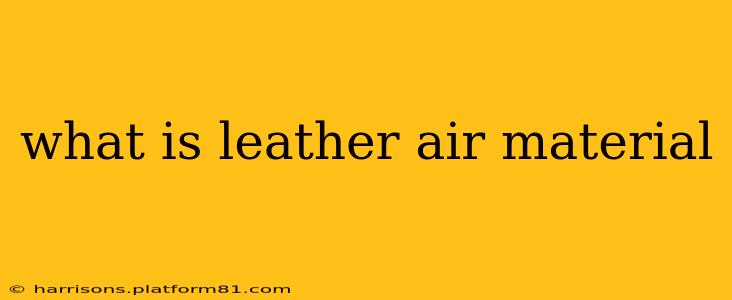What is Leather Air Material? Decoding the Mystery Behind This Breathable Leather
Leather, a material prized for its durability and luxurious feel, has seen significant advancements in recent years. One such innovation is "leather air material," a term that often pops up in discussions about high-performance athletic apparel and luxury goods. But what exactly is leather air material? Let's delve into the specifics.
The term "leather air material" isn't a standardized industry term like "full-grain leather" or "nubuck." Instead, it's a more general descriptor used to highlight a specific type of leather processing that prioritizes breathability and lightness. It usually refers to leather that has undergone a specific treatment or construction method to enhance its air permeability. This doesn't refer to a single specific type of leather, but rather a range of techniques used to achieve a similar outcome.
Several techniques can contribute to creating a "leather air" effect:
-
Perforation: This is the most common method. Tiny holes are punched into the leather, allowing for increased airflow. The density and pattern of these perforations can vary widely, influencing the level of breathability and the overall aesthetic. A finely perforated leather will be more breathable but potentially less durable than one with larger, less frequent holes.
-
Thinning: Reducing the thickness of the leather naturally makes it more breathable. However, this must be done carefully to avoid compromising the leather's strength and durability.
-
Special Treatments: Some manufacturers utilize specific tanning or finishing processes to improve the leather's breathability. These treatments may involve the application of breathable coatings or the use of special chemicals that don't obstruct airflow. Details on these specific treatments are often proprietary.
-
Lamination: Some "leather air" materials might involve bonding a layer of breathable fabric or membrane to a thinner layer of leather, creating a composite material that balances breathability with durability. This is common in sportswear applications.
What are the benefits of leather air material?
The primary advantage of leather air material is its enhanced breathability. This makes it suitable for applications where comfort and ventilation are crucial, such as:
-
Athletic Apparel: Gloves, shoes, and other athletic gear benefit from the combination of leather's durability and the improved breathability of the "air" version.
-
Luxury Goods: High-end bags, jackets, and other leather goods can be made lighter and more comfortable with this material.
-
Automotive Interiors: While less common, some high-end car interiors may utilize perforated leather to improve ventilation and comfort, particularly in warmer climates.
Is leather air material durable?
The durability of leather air material depends heavily on the specific manufacturing process and the type of leather used as a base. While perforation does improve breathability, it also potentially reduces the leather's overall strength. Thinning the leather can also impact its longevity. Therefore, it's important to consider the intended use and the quality of the manufacturing when evaluating its durability.
How is leather air material different from regular leather?
The key difference lies in its breathability. Regular leather, particularly thicker varieties, is relatively less breathable. Leather air material prioritizes airflow through perforation, thinning, or other treatments. This results in a material that is lighter, more comfortable, and better suited for situations where ventilation is important.
Where can I find products made with leather air material?
Unfortunately, you're unlikely to find products explicitly labeled as "leather air material." The term is a more general descriptor. Look for products that emphasize breathability, lightweight design, and use perforated or thinned leather in their descriptions. High-end athletic brands and luxury goods manufacturers often utilize these techniques.
By understanding the various methods used to create breathable leather, consumers can make informed decisions when purchasing products described with terms like "leather air material." Remember to always check the product description carefully for specifics on the type of leather and manufacturing processes used.
